Domino’s Marketing Analysis
VerifiedAdded on 2023/04/12
|18
|2572
|243
AI Summary
This report explores Domino's Pizza and its market capability with focus on the micro and macro-environment factors through the application of SWOT and PESTEL analysis.
Contribute Materials
Your contribution can guide someone’s learning journey. Share your
documents today.
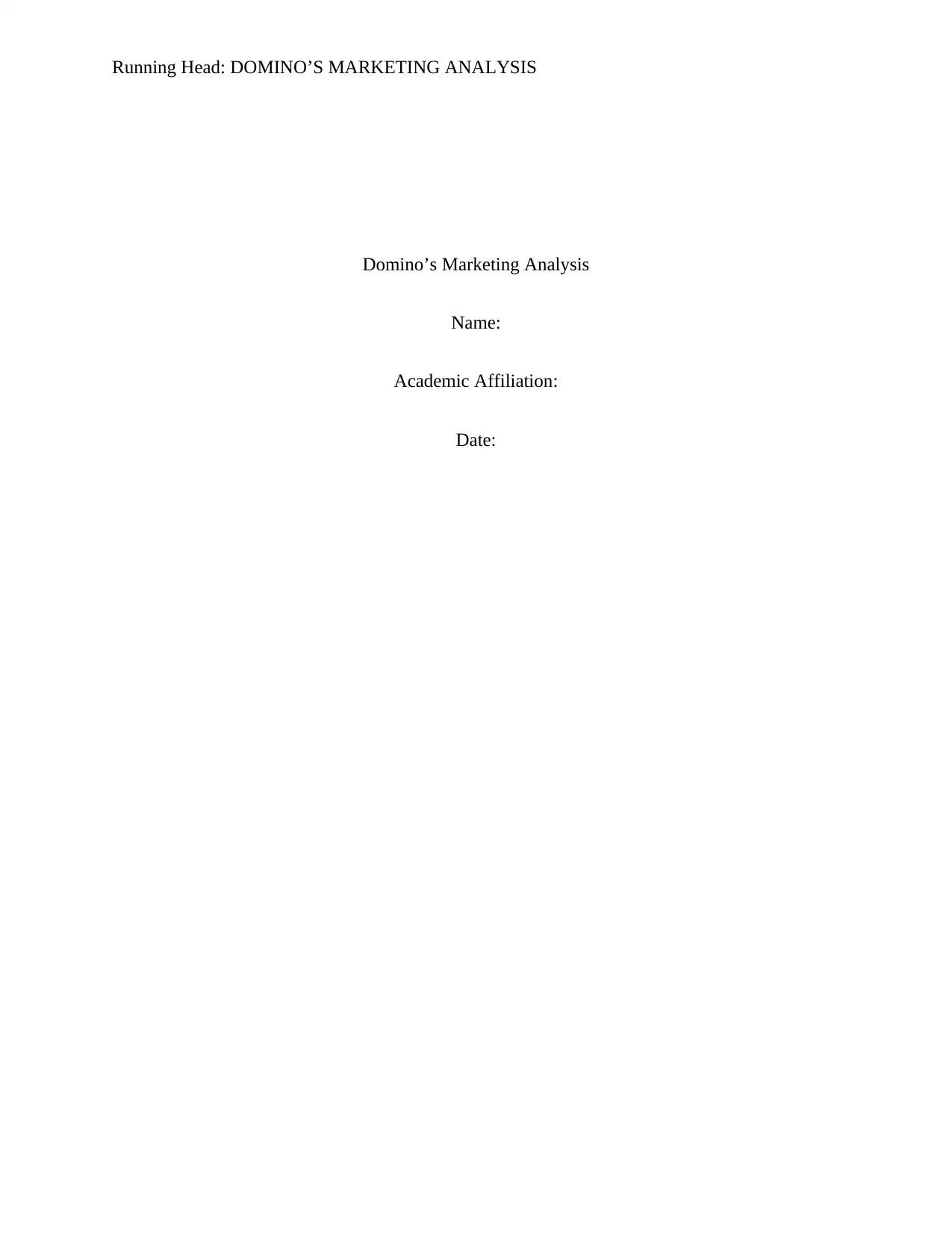
Running Head: DOMINO’S MARKETING ANALYSIS
Domino’s Marketing Analysis
Name:
Academic Affiliation:
Date:
Domino’s Marketing Analysis
Name:
Academic Affiliation:
Date:
Secure Best Marks with AI Grader
Need help grading? Try our AI Grader for instant feedback on your assignments.
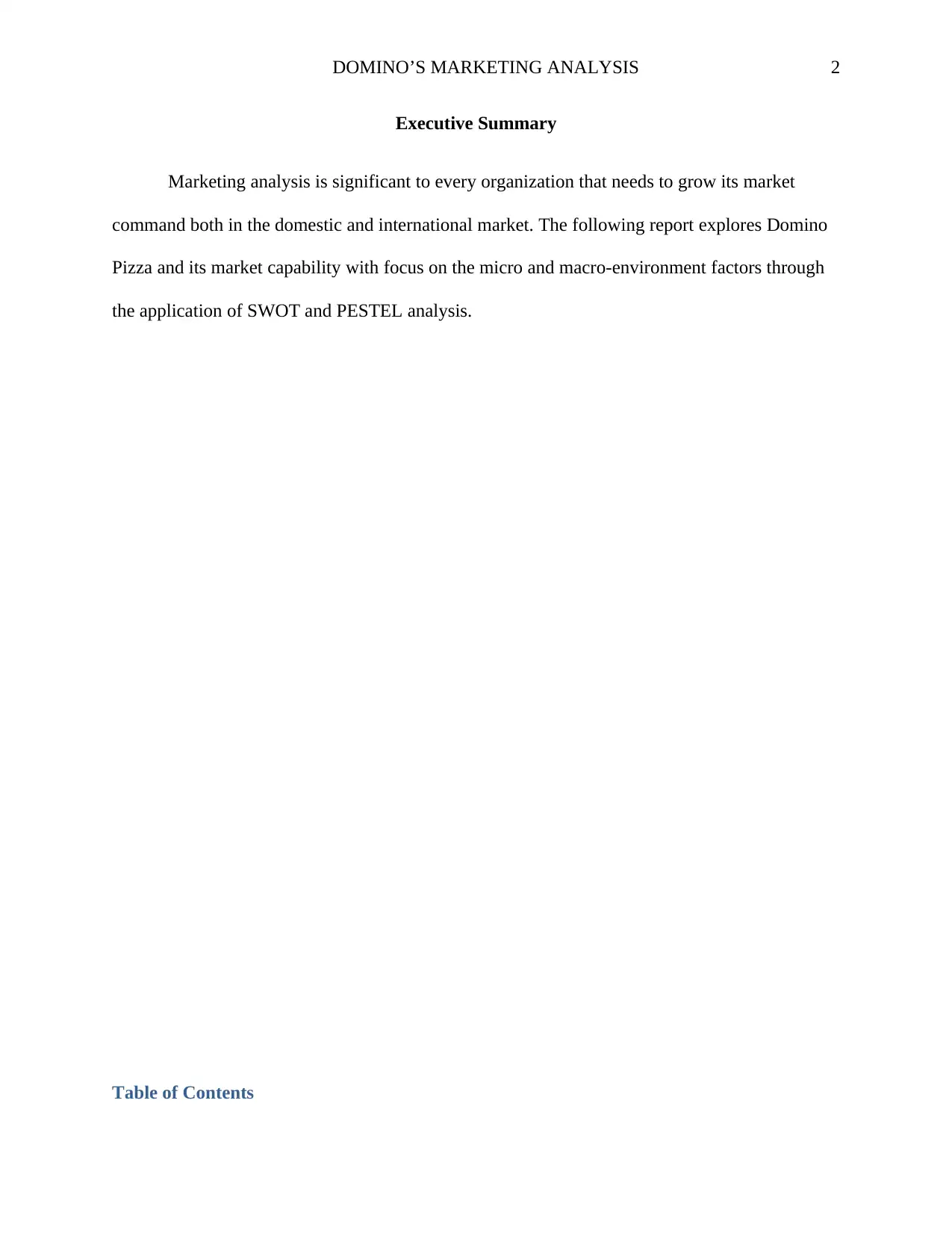
DOMINO’S MARKETING ANALYSIS 2
Executive Summary
Marketing analysis is significant to every organization that needs to grow its market
command both in the domestic and international market. The following report explores Domino
Pizza and its market capability with focus on the micro and macro-environment factors through
the application of SWOT and PESTEL analysis.
Table of Contents
Executive Summary
Marketing analysis is significant to every organization that needs to grow its market
command both in the domestic and international market. The following report explores Domino
Pizza and its market capability with focus on the micro and macro-environment factors through
the application of SWOT and PESTEL analysis.
Table of Contents
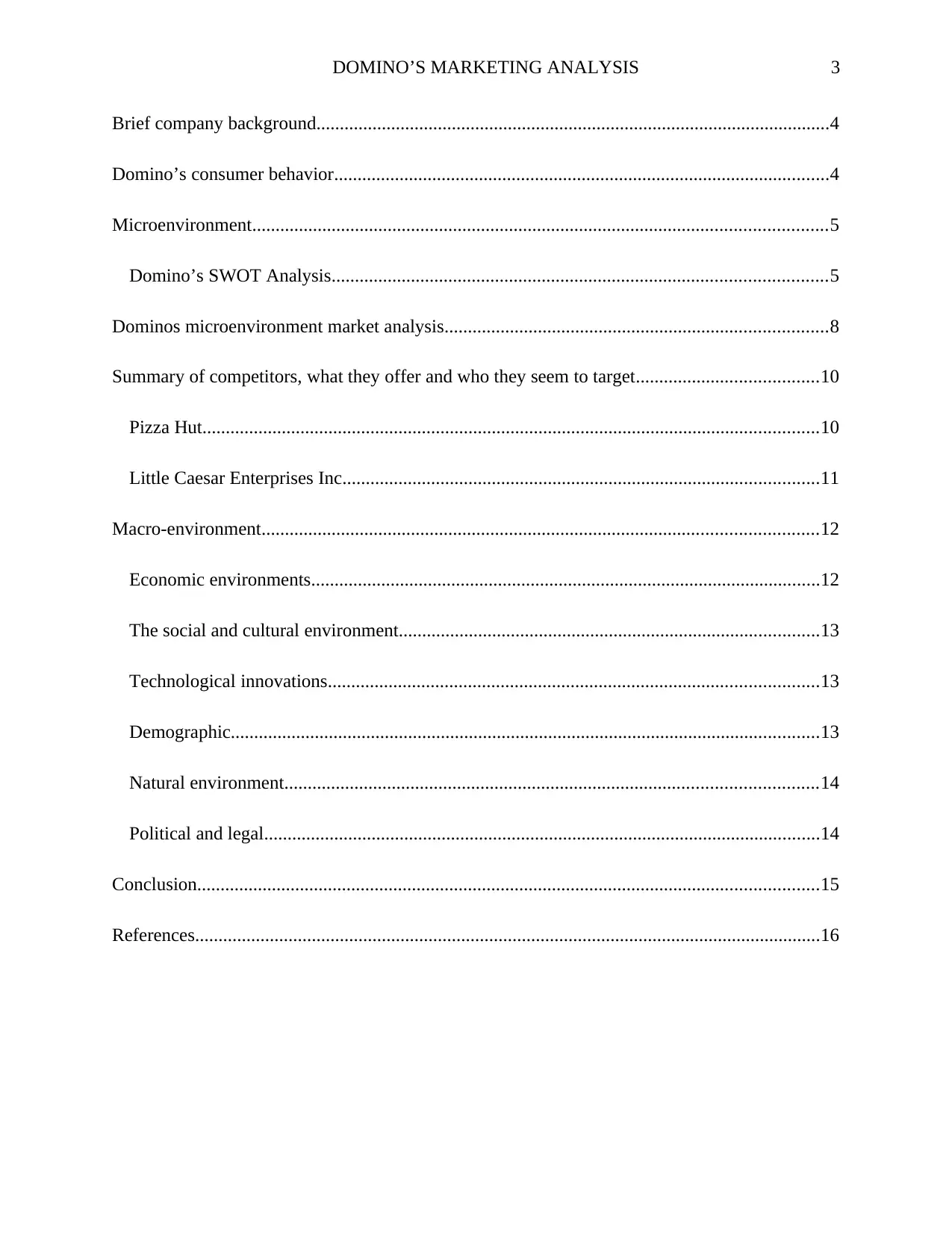
DOMINO’S MARKETING ANALYSIS 3
Brief company background..............................................................................................................4
Domino’s consumer behavior..........................................................................................................4
Microenvironment...........................................................................................................................5
Domino’s SWOT Analysis..........................................................................................................5
Dominos microenvironment market analysis..................................................................................8
Summary of competitors, what they offer and who they seem to target.......................................10
Pizza Hut....................................................................................................................................10
Little Caesar Enterprises Inc......................................................................................................11
Macro-environment.......................................................................................................................12
Economic environments.............................................................................................................12
The social and cultural environment..........................................................................................13
Technological innovations.........................................................................................................13
Demographic..............................................................................................................................13
Natural environment..................................................................................................................14
Political and legal.......................................................................................................................14
Conclusion.....................................................................................................................................15
References......................................................................................................................................16
Brief company background..............................................................................................................4
Domino’s consumer behavior..........................................................................................................4
Microenvironment...........................................................................................................................5
Domino’s SWOT Analysis..........................................................................................................5
Dominos microenvironment market analysis..................................................................................8
Summary of competitors, what they offer and who they seem to target.......................................10
Pizza Hut....................................................................................................................................10
Little Caesar Enterprises Inc......................................................................................................11
Macro-environment.......................................................................................................................12
Economic environments.............................................................................................................12
The social and cultural environment..........................................................................................13
Technological innovations.........................................................................................................13
Demographic..............................................................................................................................13
Natural environment..................................................................................................................14
Political and legal.......................................................................................................................14
Conclusion.....................................................................................................................................15
References......................................................................................................................................16
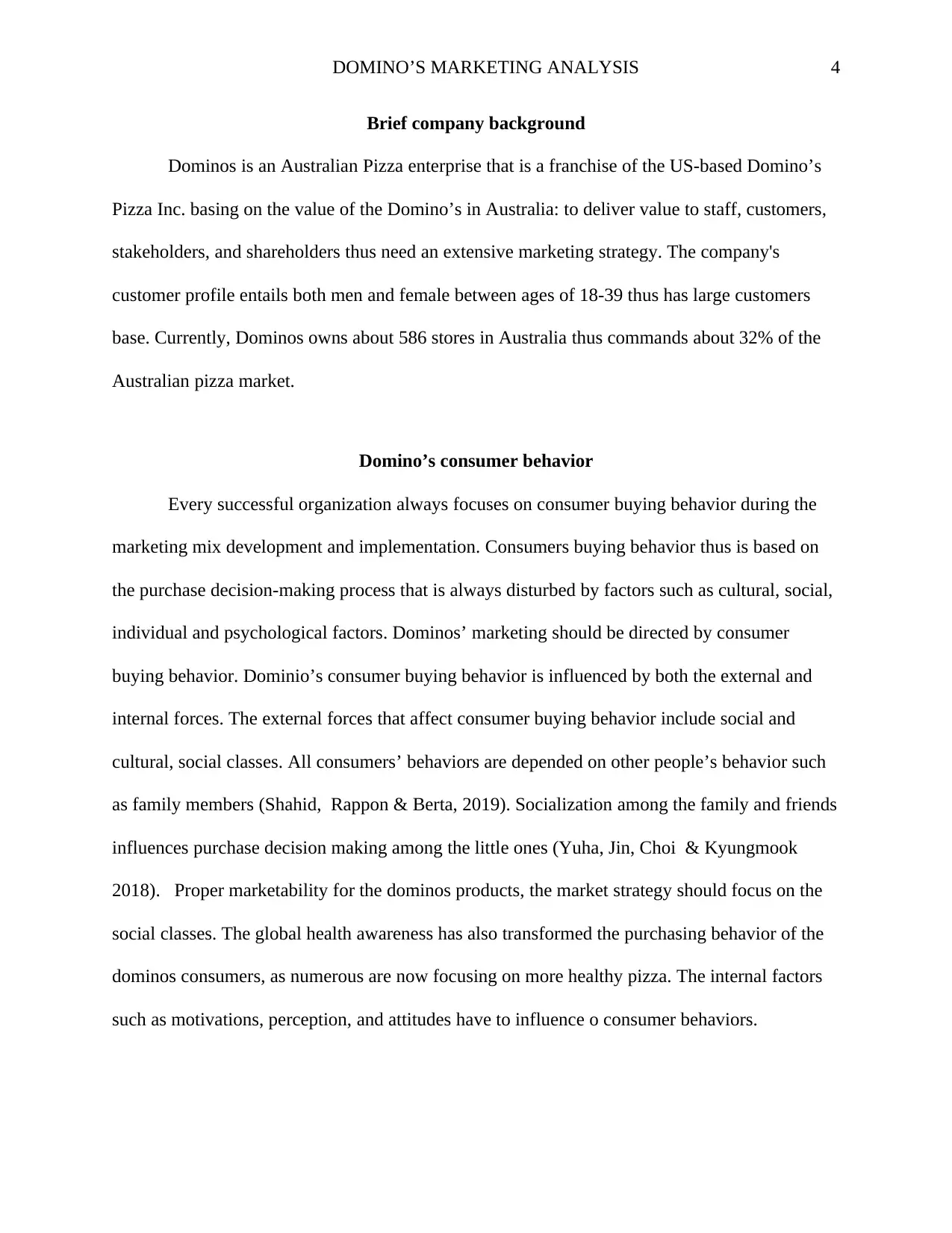
DOMINO’S MARKETING ANALYSIS 4
Brief company background
Dominos is an Australian Pizza enterprise that is a franchise of the US-based Domino’s
Pizza Inc. basing on the value of the Domino’s in Australia: to deliver value to staff, customers,
stakeholders, and shareholders thus need an extensive marketing strategy. The company's
customer profile entails both men and female between ages of 18-39 thus has large customers
base. Currently, Dominos owns about 586 stores in Australia thus commands about 32% of the
Australian pizza market.
Domino’s consumer behavior
Every successful organization always focuses on consumer buying behavior during the
marketing mix development and implementation. Consumers buying behavior thus is based on
the purchase decision-making process that is always disturbed by factors such as cultural, social,
individual and psychological factors. Dominos’ marketing should be directed by consumer
buying behavior. Dominio’s consumer buying behavior is influenced by both the external and
internal forces. The external forces that affect consumer buying behavior include social and
cultural, social classes. All consumers’ behaviors are depended on other people’s behavior such
as family members (Shahid, Rappon & Berta, 2019). Socialization among the family and friends
influences purchase decision making among the little ones (Yuha, Jin, Choi & Kyungmook
2018). Proper marketability for the dominos products, the market strategy should focus on the
social classes. The global health awareness has also transformed the purchasing behavior of the
dominos consumers, as numerous are now focusing on more healthy pizza. The internal factors
such as motivations, perception, and attitudes have to influence o consumer behaviors.
Brief company background
Dominos is an Australian Pizza enterprise that is a franchise of the US-based Domino’s
Pizza Inc. basing on the value of the Domino’s in Australia: to deliver value to staff, customers,
stakeholders, and shareholders thus need an extensive marketing strategy. The company's
customer profile entails both men and female between ages of 18-39 thus has large customers
base. Currently, Dominos owns about 586 stores in Australia thus commands about 32% of the
Australian pizza market.
Domino’s consumer behavior
Every successful organization always focuses on consumer buying behavior during the
marketing mix development and implementation. Consumers buying behavior thus is based on
the purchase decision-making process that is always disturbed by factors such as cultural, social,
individual and psychological factors. Dominos’ marketing should be directed by consumer
buying behavior. Dominio’s consumer buying behavior is influenced by both the external and
internal forces. The external forces that affect consumer buying behavior include social and
cultural, social classes. All consumers’ behaviors are depended on other people’s behavior such
as family members (Shahid, Rappon & Berta, 2019). Socialization among the family and friends
influences purchase decision making among the little ones (Yuha, Jin, Choi & Kyungmook
2018). Proper marketability for the dominos products, the market strategy should focus on the
social classes. The global health awareness has also transformed the purchasing behavior of the
dominos consumers, as numerous are now focusing on more healthy pizza. The internal factors
such as motivations, perception, and attitudes have to influence o consumer behaviors.
Secure Best Marks with AI Grader
Need help grading? Try our AI Grader for instant feedback on your assignments.
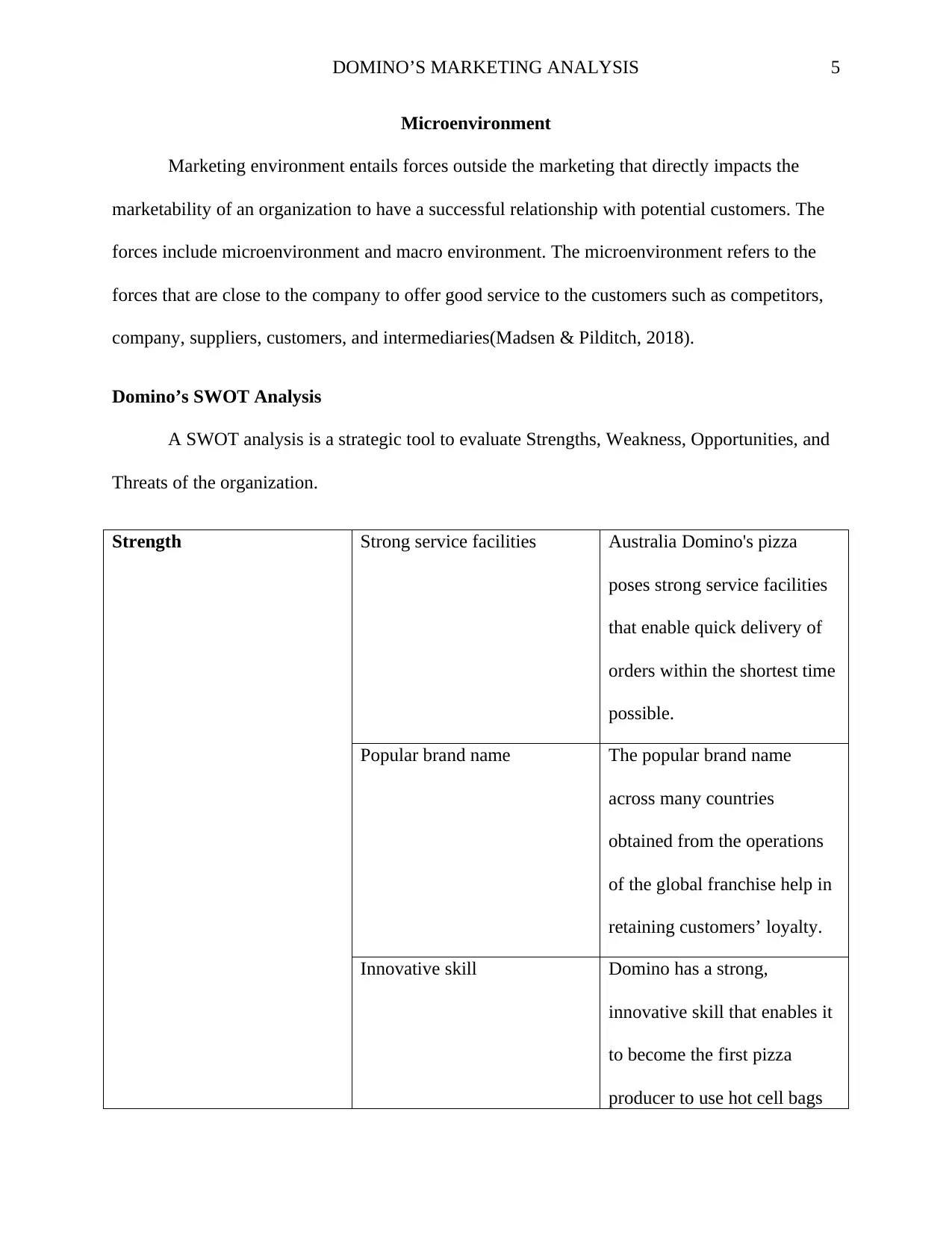
DOMINO’S MARKETING ANALYSIS 5
Microenvironment
Marketing environment entails forces outside the marketing that directly impacts the
marketability of an organization to have a successful relationship with potential customers. The
forces include microenvironment and macro environment. The microenvironment refers to the
forces that are close to the company to offer good service to the customers such as competitors,
company, suppliers, customers, and intermediaries(Madsen & Pilditch, 2018).
Domino’s SWOT Analysis
A SWOT analysis is a strategic tool to evaluate Strengths, Weakness, Opportunities, and
Threats of the organization.
Strength Strong service facilities Australia Domino's pizza
poses strong service facilities
that enable quick delivery of
orders within the shortest time
possible.
Popular brand name The popular brand name
across many countries
obtained from the operations
of the global franchise help in
retaining customers’ loyalty.
Innovative skill Domino has a strong,
innovative skill that enables it
to become the first pizza
producer to use hot cell bags
Microenvironment
Marketing environment entails forces outside the marketing that directly impacts the
marketability of an organization to have a successful relationship with potential customers. The
forces include microenvironment and macro environment. The microenvironment refers to the
forces that are close to the company to offer good service to the customers such as competitors,
company, suppliers, customers, and intermediaries(Madsen & Pilditch, 2018).
Domino’s SWOT Analysis
A SWOT analysis is a strategic tool to evaluate Strengths, Weakness, Opportunities, and
Threats of the organization.
Strength Strong service facilities Australia Domino's pizza
poses strong service facilities
that enable quick delivery of
orders within the shortest time
possible.
Popular brand name The popular brand name
across many countries
obtained from the operations
of the global franchise help in
retaining customers’ loyalty.
Innovative skill Domino has a strong,
innovative skill that enables it
to become the first pizza
producer to use hot cell bags
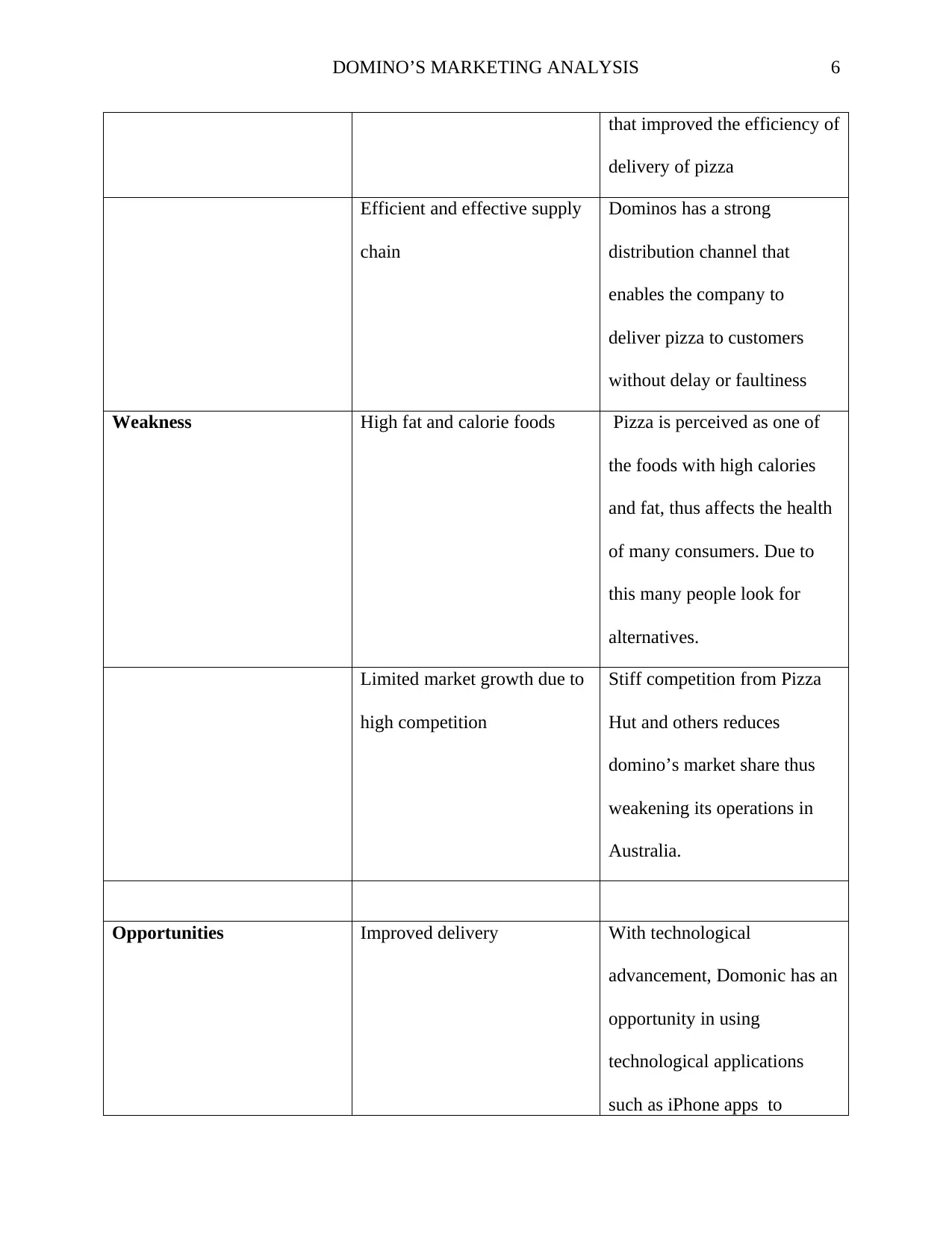
DOMINO’S MARKETING ANALYSIS 6
that improved the efficiency of
delivery of pizza
Efficient and effective supply
chain
Dominos has a strong
distribution channel that
enables the company to
deliver pizza to customers
without delay or faultiness
Weakness High fat and calorie foods Pizza is perceived as one of
the foods with high calories
and fat, thus affects the health
of many consumers. Due to
this many people look for
alternatives.
Limited market growth due to
high competition
Stiff competition from Pizza
Hut and others reduces
domino’s market share thus
weakening its operations in
Australia.
Opportunities Improved delivery With technological
advancement, Domonic has an
opportunity in using
technological applications
such as iPhone apps to
that improved the efficiency of
delivery of pizza
Efficient and effective supply
chain
Dominos has a strong
distribution channel that
enables the company to
deliver pizza to customers
without delay or faultiness
Weakness High fat and calorie foods Pizza is perceived as one of
the foods with high calories
and fat, thus affects the health
of many consumers. Due to
this many people look for
alternatives.
Limited market growth due to
high competition
Stiff competition from Pizza
Hut and others reduces
domino’s market share thus
weakening its operations in
Australia.
Opportunities Improved delivery With technological
advancement, Domonic has an
opportunity in using
technological applications
such as iPhone apps to
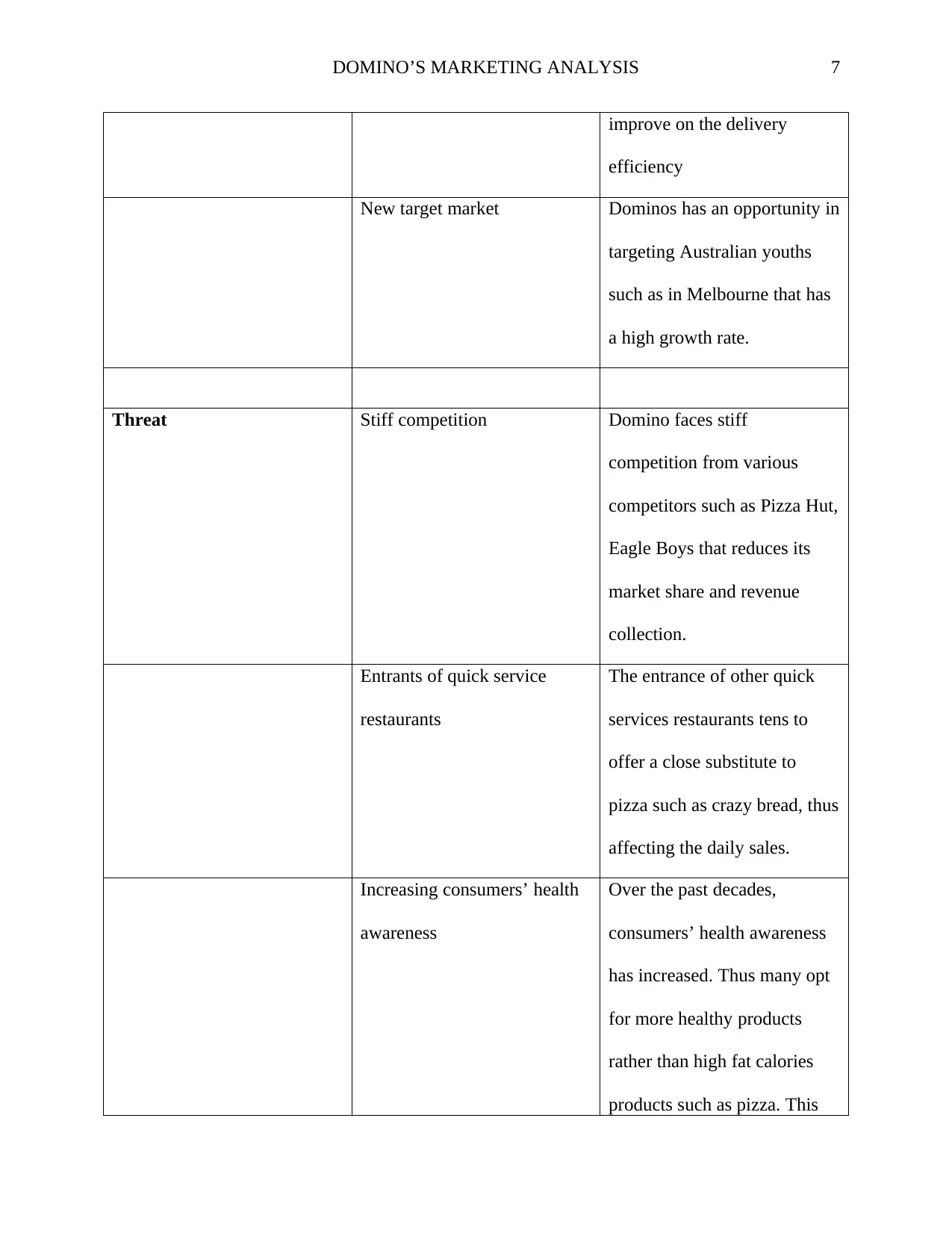
DOMINO’S MARKETING ANALYSIS 7
improve on the delivery
efficiency
New target market Dominos has an opportunity in
targeting Australian youths
such as in Melbourne that has
a high growth rate.
Threat Stiff competition Domino faces stiff
competition from various
competitors such as Pizza Hut,
Eagle Boys that reduces its
market share and revenue
collection.
Entrants of quick service
restaurants
The entrance of other quick
services restaurants tens to
offer a close substitute to
pizza such as crazy bread, thus
affecting the daily sales.
Increasing consumers’ health
awareness
Over the past decades,
consumers’ health awareness
has increased. Thus many opt
for more healthy products
rather than high fat calories
products such as pizza. This
improve on the delivery
efficiency
New target market Dominos has an opportunity in
targeting Australian youths
such as in Melbourne that has
a high growth rate.
Threat Stiff competition Domino faces stiff
competition from various
competitors such as Pizza Hut,
Eagle Boys that reduces its
market share and revenue
collection.
Entrants of quick service
restaurants
The entrance of other quick
services restaurants tens to
offer a close substitute to
pizza such as crazy bread, thus
affecting the daily sales.
Increasing consumers’ health
awareness
Over the past decades,
consumers’ health awareness
has increased. Thus many opt
for more healthy products
rather than high fat calories
products such as pizza. This
Paraphrase This Document
Need a fresh take? Get an instant paraphrase of this document with our AI Paraphraser
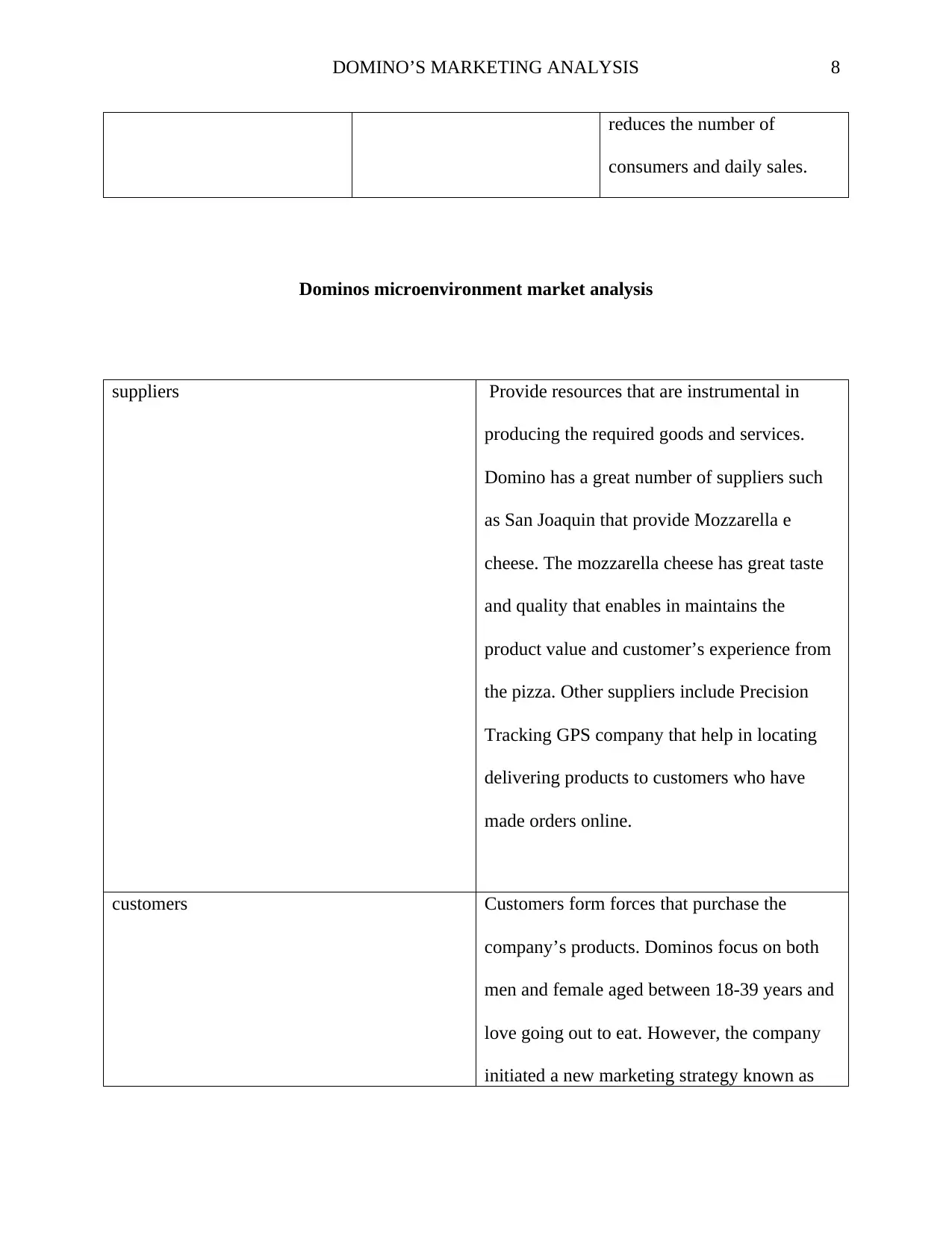
DOMINO’S MARKETING ANALYSIS 8
reduces the number of
consumers and daily sales.
Dominos microenvironment market analysis
suppliers Provide resources that are instrumental in
producing the required goods and services.
Domino has a great number of suppliers such
as San Joaquin that provide Mozzarella e
cheese. The mozzarella cheese has great taste
and quality that enables in maintains the
product value and customer’s experience from
the pizza. Other suppliers include Precision
Tracking GPS company that help in locating
delivering products to customers who have
made orders online.
customers Customers form forces that purchase the
company’s products. Dominos focus on both
men and female aged between 18-39 years and
love going out to eat. However, the company
initiated a new marketing strategy known as
reduces the number of
consumers and daily sales.
Dominos microenvironment market analysis
suppliers Provide resources that are instrumental in
producing the required goods and services.
Domino has a great number of suppliers such
as San Joaquin that provide Mozzarella e
cheese. The mozzarella cheese has great taste
and quality that enables in maintains the
product value and customer’s experience from
the pizza. Other suppliers include Precision
Tracking GPS company that help in locating
delivering products to customers who have
made orders online.
customers Customers form forces that purchase the
company’s products. Dominos focus on both
men and female aged between 18-39 years and
love going out to eat. However, the company
initiated a new marketing strategy known as
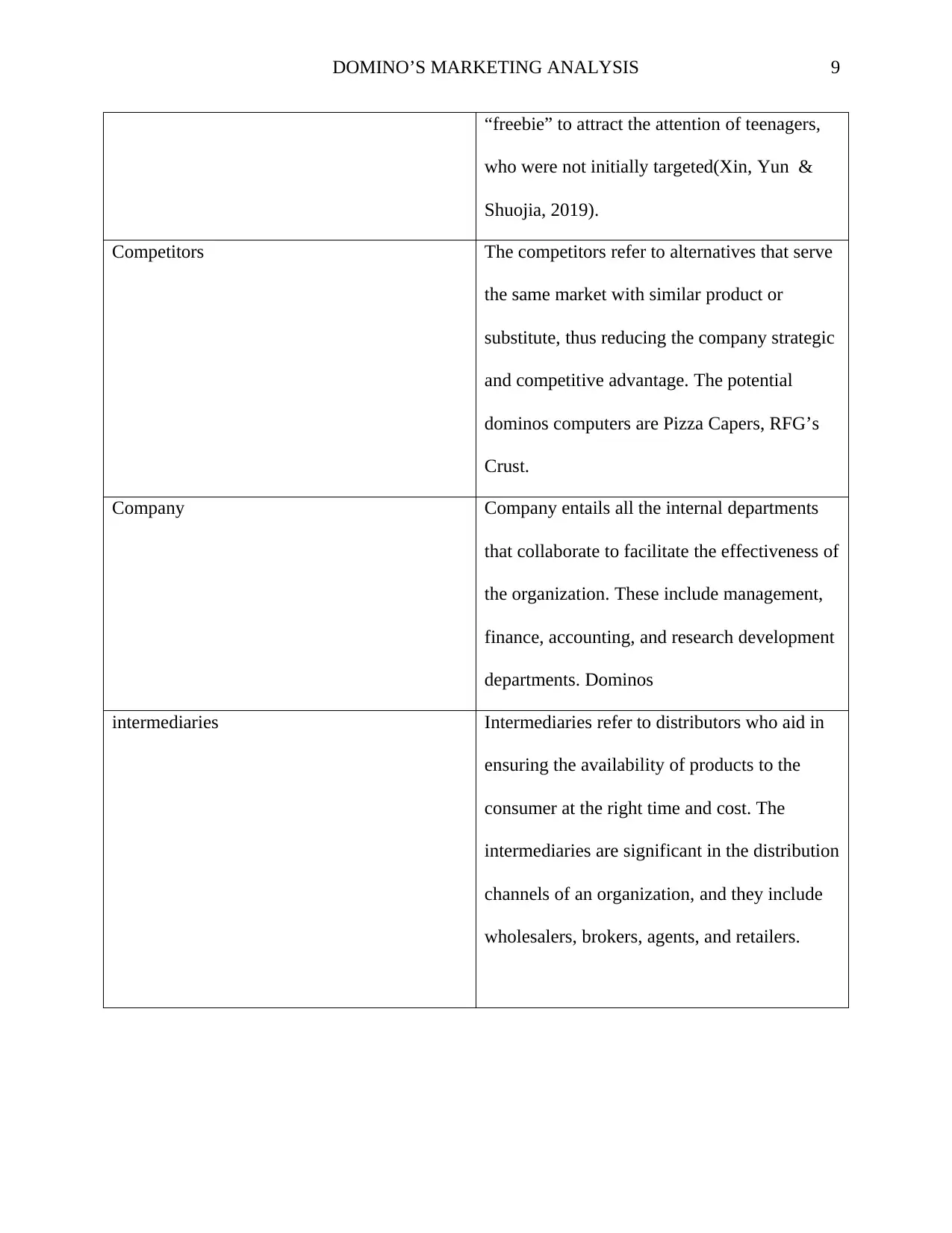
DOMINO’S MARKETING ANALYSIS 9
“freebie” to attract the attention of teenagers,
who were not initially targeted(Xin, Yun &
Shuojia, 2019).
Competitors The competitors refer to alternatives that serve
the same market with similar product or
substitute, thus reducing the company strategic
and competitive advantage. The potential
dominos computers are Pizza Capers, RFG’s
Crust.
Company Company entails all the internal departments
that collaborate to facilitate the effectiveness of
the organization. These include management,
finance, accounting, and research development
departments. Dominos
intermediaries Intermediaries refer to distributors who aid in
ensuring the availability of products to the
consumer at the right time and cost. The
intermediaries are significant in the distribution
channels of an organization, and they include
wholesalers, brokers, agents, and retailers.
“freebie” to attract the attention of teenagers,
who were not initially targeted(Xin, Yun &
Shuojia, 2019).
Competitors The competitors refer to alternatives that serve
the same market with similar product or
substitute, thus reducing the company strategic
and competitive advantage. The potential
dominos computers are Pizza Capers, RFG’s
Crust.
Company Company entails all the internal departments
that collaborate to facilitate the effectiveness of
the organization. These include management,
finance, accounting, and research development
departments. Dominos
intermediaries Intermediaries refer to distributors who aid in
ensuring the availability of products to the
consumer at the right time and cost. The
intermediaries are significant in the distribution
channels of an organization, and they include
wholesalers, brokers, agents, and retailers.
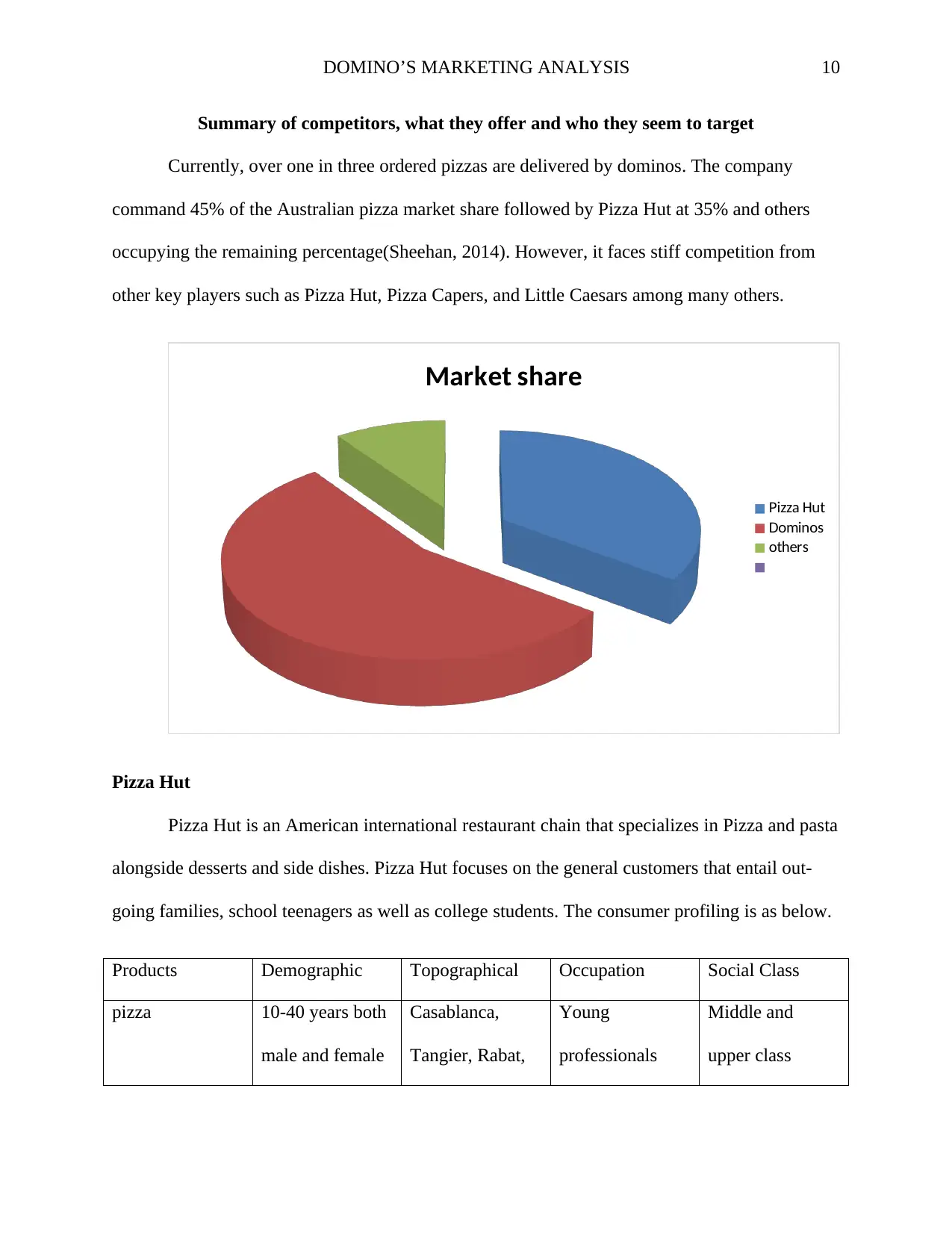
DOMINO’S MARKETING ANALYSIS 10
Summary of competitors, what they offer and who they seem to target
Currently, over one in three ordered pizzas are delivered by dominos. The company
command 45% of the Australian pizza market share followed by Pizza Hut at 35% and others
occupying the remaining percentage(Sheehan, 2014). However, it faces stiff competition from
other key players such as Pizza Hut, Pizza Capers, and Little Caesars among many others.
Market share
Pizza Hut
Dominos
others
Pizza Hut
Pizza Hut is an American international restaurant chain that specializes in Pizza and pasta
alongside desserts and side dishes. Pizza Hut focuses on the general customers that entail out-
going families, school teenagers as well as college students. The consumer profiling is as below.
Products Demographic Topographical Occupation Social Class
pizza 10-40 years both
male and female
Casablanca,
Tangier, Rabat,
Young
professionals
Middle and
upper class
Summary of competitors, what they offer and who they seem to target
Currently, over one in three ordered pizzas are delivered by dominos. The company
command 45% of the Australian pizza market share followed by Pizza Hut at 35% and others
occupying the remaining percentage(Sheehan, 2014). However, it faces stiff competition from
other key players such as Pizza Hut, Pizza Capers, and Little Caesars among many others.
Market share
Pizza Hut
Dominos
others
Pizza Hut
Pizza Hut is an American international restaurant chain that specializes in Pizza and pasta
alongside desserts and side dishes. Pizza Hut focuses on the general customers that entail out-
going families, school teenagers as well as college students. The consumer profiling is as below.
Products Demographic Topographical Occupation Social Class
pizza 10-40 years both
male and female
Casablanca,
Tangier, Rabat,
Young
professionals
Middle and
upper class
Secure Best Marks with AI Grader
Need help grading? Try our AI Grader for instant feedback on your assignments.
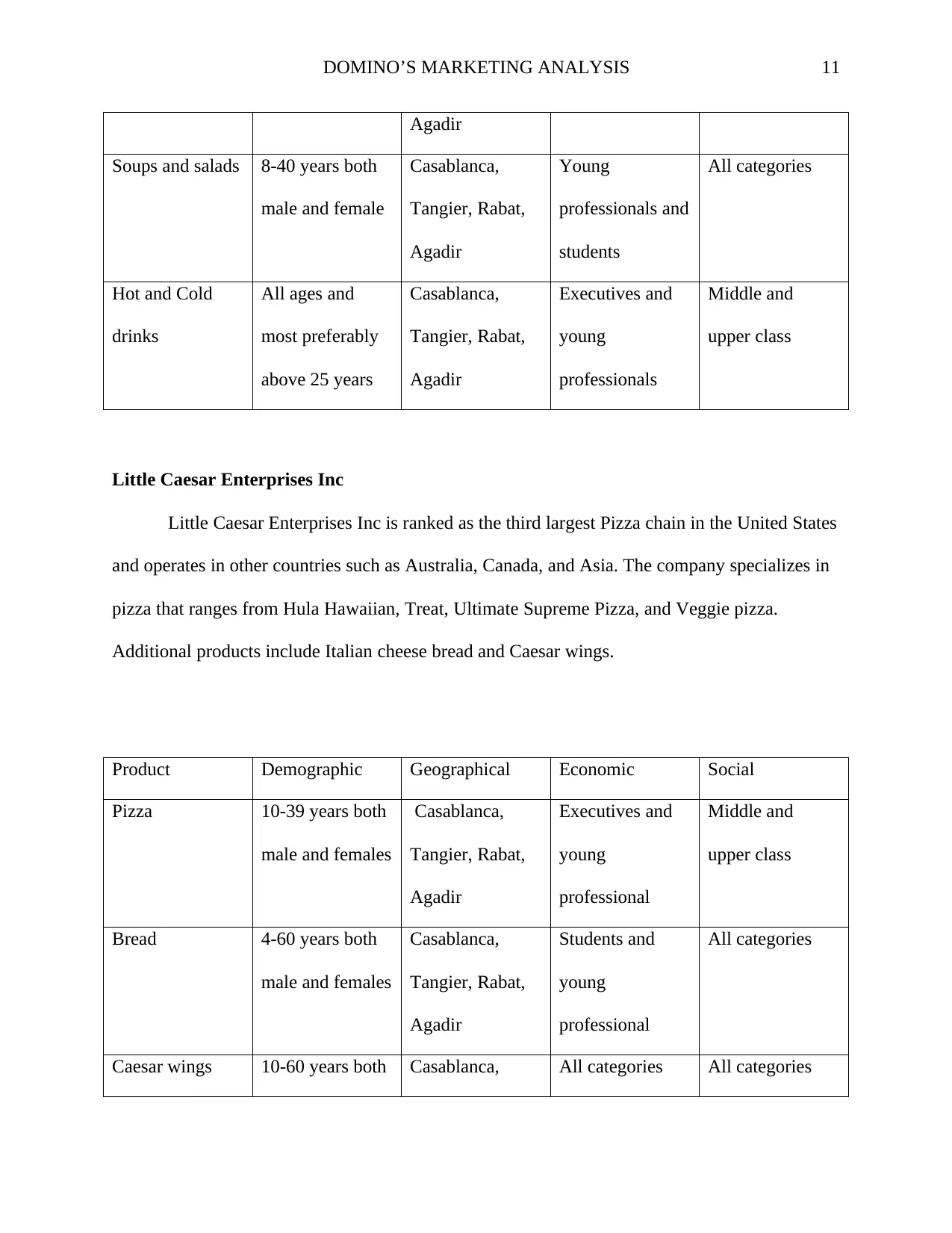
DOMINO’S MARKETING ANALYSIS 11
Agadir
Soups and salads 8-40 years both
male and female
Casablanca,
Tangier, Rabat,
Agadir
Young
professionals and
students
All categories
Hot and Cold
drinks
All ages and
most preferably
above 25 years
Casablanca,
Tangier, Rabat,
Agadir
Executives and
young
professionals
Middle and
upper class
Little Caesar Enterprises Inc
Little Caesar Enterprises Inc is ranked as the third largest Pizza chain in the United States
and operates in other countries such as Australia, Canada, and Asia. The company specializes in
pizza that ranges from Hula Hawaiian, Treat, Ultimate Supreme Pizza, and Veggie pizza.
Additional products include Italian cheese bread and Caesar wings.
Product Demographic Geographical Economic Social
Pizza 10-39 years both
male and females
Casablanca,
Tangier, Rabat,
Agadir
Executives and
young
professional
Middle and
upper class
Bread 4-60 years both
male and females
Casablanca,
Tangier, Rabat,
Agadir
Students and
young
professional
All categories
Caesar wings 10-60 years both Casablanca, All categories All categories
Agadir
Soups and salads 8-40 years both
male and female
Casablanca,
Tangier, Rabat,
Agadir
Young
professionals and
students
All categories
Hot and Cold
drinks
All ages and
most preferably
above 25 years
Casablanca,
Tangier, Rabat,
Agadir
Executives and
young
professionals
Middle and
upper class
Little Caesar Enterprises Inc
Little Caesar Enterprises Inc is ranked as the third largest Pizza chain in the United States
and operates in other countries such as Australia, Canada, and Asia. The company specializes in
pizza that ranges from Hula Hawaiian, Treat, Ultimate Supreme Pizza, and Veggie pizza.
Additional products include Italian cheese bread and Caesar wings.
Product Demographic Geographical Economic Social
Pizza 10-39 years both
male and females
Casablanca,
Tangier, Rabat,
Agadir
Executives and
young
professional
Middle and
upper class
Bread 4-60 years both
male and females
Casablanca,
Tangier, Rabat,
Agadir
Students and
young
professional
All categories
Caesar wings 10-60 years both Casablanca, All categories All categories
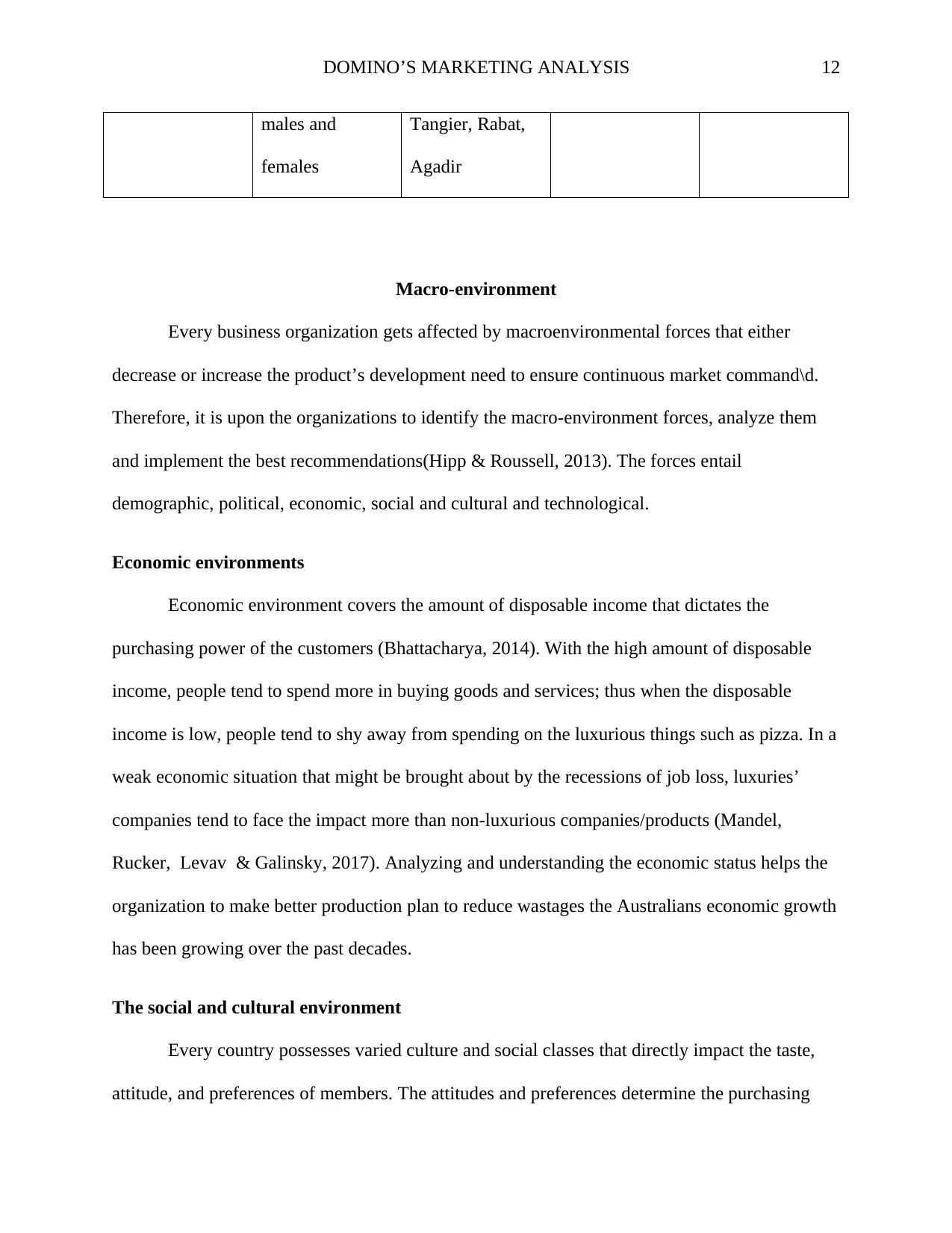
DOMINO’S MARKETING ANALYSIS 12
males and
females
Tangier, Rabat,
Agadir
Macro-environment
Every business organization gets affected by macroenvironmental forces that either
decrease or increase the product’s development need to ensure continuous market command\d.
Therefore, it is upon the organizations to identify the macro-environment forces, analyze them
and implement the best recommendations(Hipp & Roussell, 2013). The forces entail
demographic, political, economic, social and cultural and technological.
Economic environments
Economic environment covers the amount of disposable income that dictates the
purchasing power of the customers (Bhattacharya, 2014). With the high amount of disposable
income, people tend to spend more in buying goods and services; thus when the disposable
income is low, people tend to shy away from spending on the luxurious things such as pizza. In a
weak economic situation that might be brought about by the recessions of job loss, luxuries’
companies tend to face the impact more than non-luxurious companies/products (Mandel,
Rucker, Levav & Galinsky, 2017). Analyzing and understanding the economic status helps the
organization to make better production plan to reduce wastages the Australians economic growth
has been growing over the past decades.
The social and cultural environment
Every country possesses varied culture and social classes that directly impact the taste,
attitude, and preferences of members. The attitudes and preferences determine the purchasing
males and
females
Tangier, Rabat,
Agadir
Macro-environment
Every business organization gets affected by macroenvironmental forces that either
decrease or increase the product’s development need to ensure continuous market command\d.
Therefore, it is upon the organizations to identify the macro-environment forces, analyze them
and implement the best recommendations(Hipp & Roussell, 2013). The forces entail
demographic, political, economic, social and cultural and technological.
Economic environments
Economic environment covers the amount of disposable income that dictates the
purchasing power of the customers (Bhattacharya, 2014). With the high amount of disposable
income, people tend to spend more in buying goods and services; thus when the disposable
income is low, people tend to shy away from spending on the luxurious things such as pizza. In a
weak economic situation that might be brought about by the recessions of job loss, luxuries’
companies tend to face the impact more than non-luxurious companies/products (Mandel,
Rucker, Levav & Galinsky, 2017). Analyzing and understanding the economic status helps the
organization to make better production plan to reduce wastages the Australians economic growth
has been growing over the past decades.
The social and cultural environment
Every country possesses varied culture and social classes that directly impact the taste,
attitude, and preferences of members. The attitudes and preferences determine the purchasing
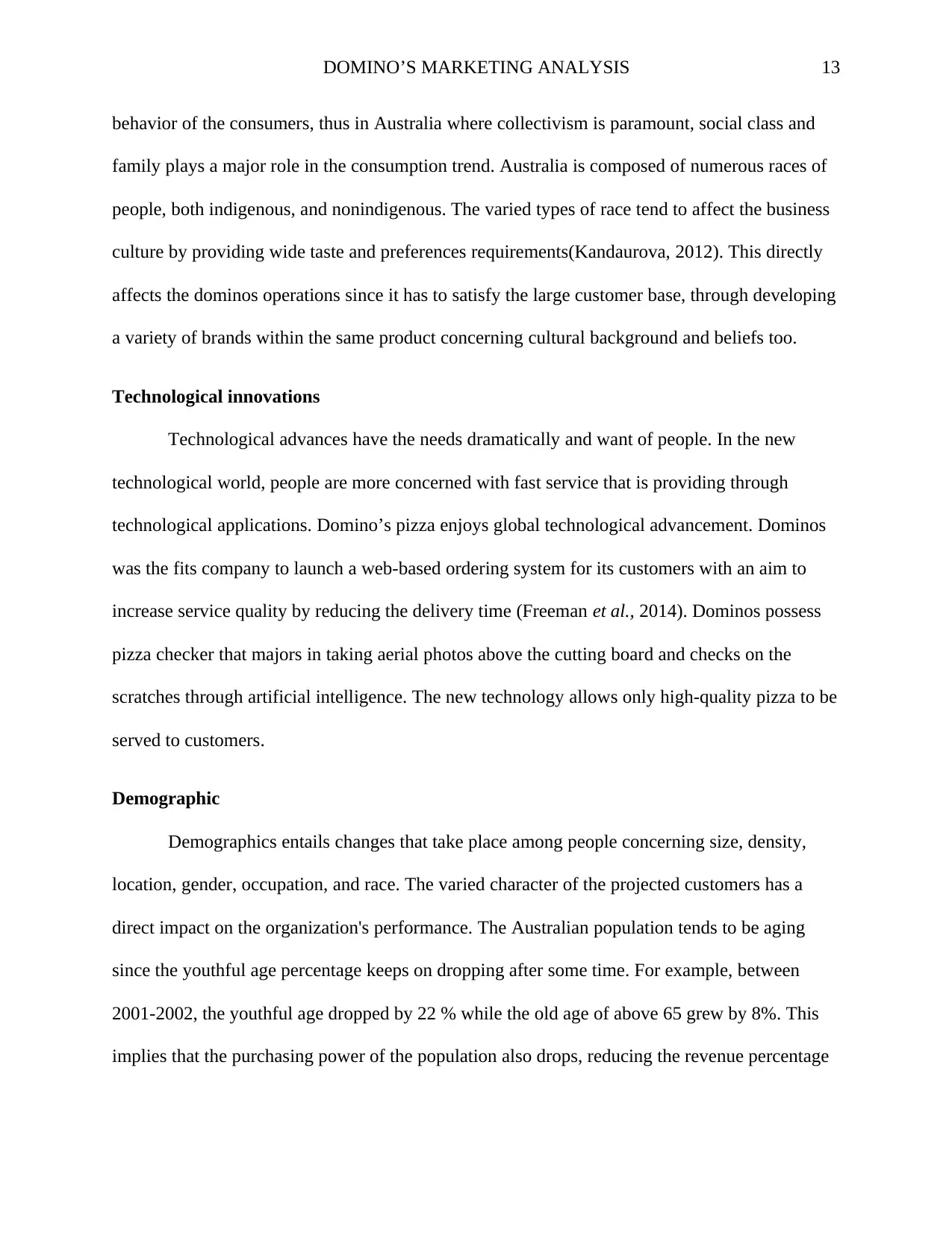
DOMINO’S MARKETING ANALYSIS 13
behavior of the consumers, thus in Australia where collectivism is paramount, social class and
family plays a major role in the consumption trend. Australia is composed of numerous races of
people, both indigenous, and nonindigenous. The varied types of race tend to affect the business
culture by providing wide taste and preferences requirements(Kandaurova, 2012). This directly
affects the dominos operations since it has to satisfy the large customer base, through developing
a variety of brands within the same product concerning cultural background and beliefs too.
Technological innovations
Technological advances have the needs dramatically and want of people. In the new
technological world, people are more concerned with fast service that is providing through
technological applications. Domino’s pizza enjoys global technological advancement. Dominos
was the fits company to launch a web-based ordering system for its customers with an aim to
increase service quality by reducing the delivery time (Freeman et al., 2014). Dominos possess
pizza checker that majors in taking aerial photos above the cutting board and checks on the
scratches through artificial intelligence. The new technology allows only high-quality pizza to be
served to customers.
Demographic
Demographics entails changes that take place among people concerning size, density,
location, gender, occupation, and race. The varied character of the projected customers has a
direct impact on the organization's performance. The Australian population tends to be aging
since the youthful age percentage keeps on dropping after some time. For example, between
2001-2002, the youthful age dropped by 22 % while the old age of above 65 grew by 8%. This
implies that the purchasing power of the population also drops, reducing the revenue percentage
behavior of the consumers, thus in Australia where collectivism is paramount, social class and
family plays a major role in the consumption trend. Australia is composed of numerous races of
people, both indigenous, and nonindigenous. The varied types of race tend to affect the business
culture by providing wide taste and preferences requirements(Kandaurova, 2012). This directly
affects the dominos operations since it has to satisfy the large customer base, through developing
a variety of brands within the same product concerning cultural background and beliefs too.
Technological innovations
Technological advances have the needs dramatically and want of people. In the new
technological world, people are more concerned with fast service that is providing through
technological applications. Domino’s pizza enjoys global technological advancement. Dominos
was the fits company to launch a web-based ordering system for its customers with an aim to
increase service quality by reducing the delivery time (Freeman et al., 2014). Dominos possess
pizza checker that majors in taking aerial photos above the cutting board and checks on the
scratches through artificial intelligence. The new technology allows only high-quality pizza to be
served to customers.
Demographic
Demographics entails changes that take place among people concerning size, density,
location, gender, occupation, and race. The varied character of the projected customers has a
direct impact on the organization's performance. The Australian population tends to be aging
since the youthful age percentage keeps on dropping after some time. For example, between
2001-2002, the youthful age dropped by 22 % while the old age of above 65 grew by 8%. This
implies that the purchasing power of the population also drops, reducing the revenue percentage
Paraphrase This Document
Need a fresh take? Get an instant paraphrase of this document with our AI Paraphraser
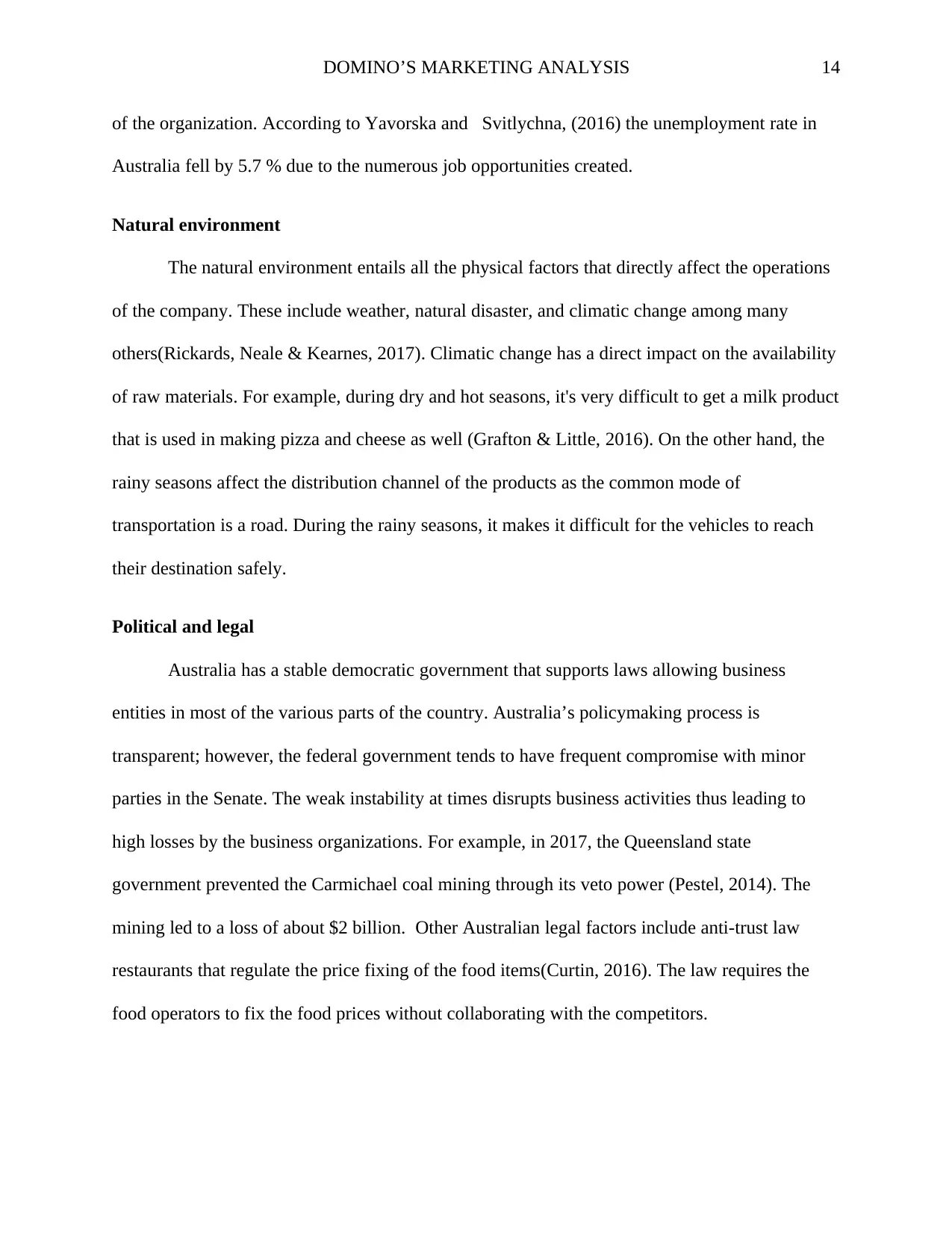
DOMINO’S MARKETING ANALYSIS 14
of the organization. According to Yavorska and Svitlychna, (2016) the unemployment rate in
Australia fell by 5.7 % due to the numerous job opportunities created.
Natural environment
The natural environment entails all the physical factors that directly affect the operations
of the company. These include weather, natural disaster, and climatic change among many
others(Rickards, Neale & Kearnes, 2017). Climatic change has a direct impact on the availability
of raw materials. For example, during dry and hot seasons, it's very difficult to get a milk product
that is used in making pizza and cheese as well (Grafton & Little, 2016). On the other hand, the
rainy seasons affect the distribution channel of the products as the common mode of
transportation is a road. During the rainy seasons, it makes it difficult for the vehicles to reach
their destination safely.
Political and legal
Australia has a stable democratic government that supports laws allowing business
entities in most of the various parts of the country. Australia’s policymaking process is
transparent; however, the federal government tends to have frequent compromise with minor
parties in the Senate. The weak instability at times disrupts business activities thus leading to
high losses by the business organizations. For example, in 2017, the Queensland state
government prevented the Carmichael coal mining through its veto power (Pestel, 2014). The
mining led to a loss of about $2 billion. Other Australian legal factors include anti-trust law
restaurants that regulate the price fixing of the food items(Curtin, 2016). The law requires the
food operators to fix the food prices without collaborating with the competitors.
of the organization. According to Yavorska and Svitlychna, (2016) the unemployment rate in
Australia fell by 5.7 % due to the numerous job opportunities created.
Natural environment
The natural environment entails all the physical factors that directly affect the operations
of the company. These include weather, natural disaster, and climatic change among many
others(Rickards, Neale & Kearnes, 2017). Climatic change has a direct impact on the availability
of raw materials. For example, during dry and hot seasons, it's very difficult to get a milk product
that is used in making pizza and cheese as well (Grafton & Little, 2016). On the other hand, the
rainy seasons affect the distribution channel of the products as the common mode of
transportation is a road. During the rainy seasons, it makes it difficult for the vehicles to reach
their destination safely.
Political and legal
Australia has a stable democratic government that supports laws allowing business
entities in most of the various parts of the country. Australia’s policymaking process is
transparent; however, the federal government tends to have frequent compromise with minor
parties in the Senate. The weak instability at times disrupts business activities thus leading to
high losses by the business organizations. For example, in 2017, the Queensland state
government prevented the Carmichael coal mining through its veto power (Pestel, 2014). The
mining led to a loss of about $2 billion. Other Australian legal factors include anti-trust law
restaurants that regulate the price fixing of the food items(Curtin, 2016). The law requires the
food operators to fix the food prices without collaborating with the competitors.
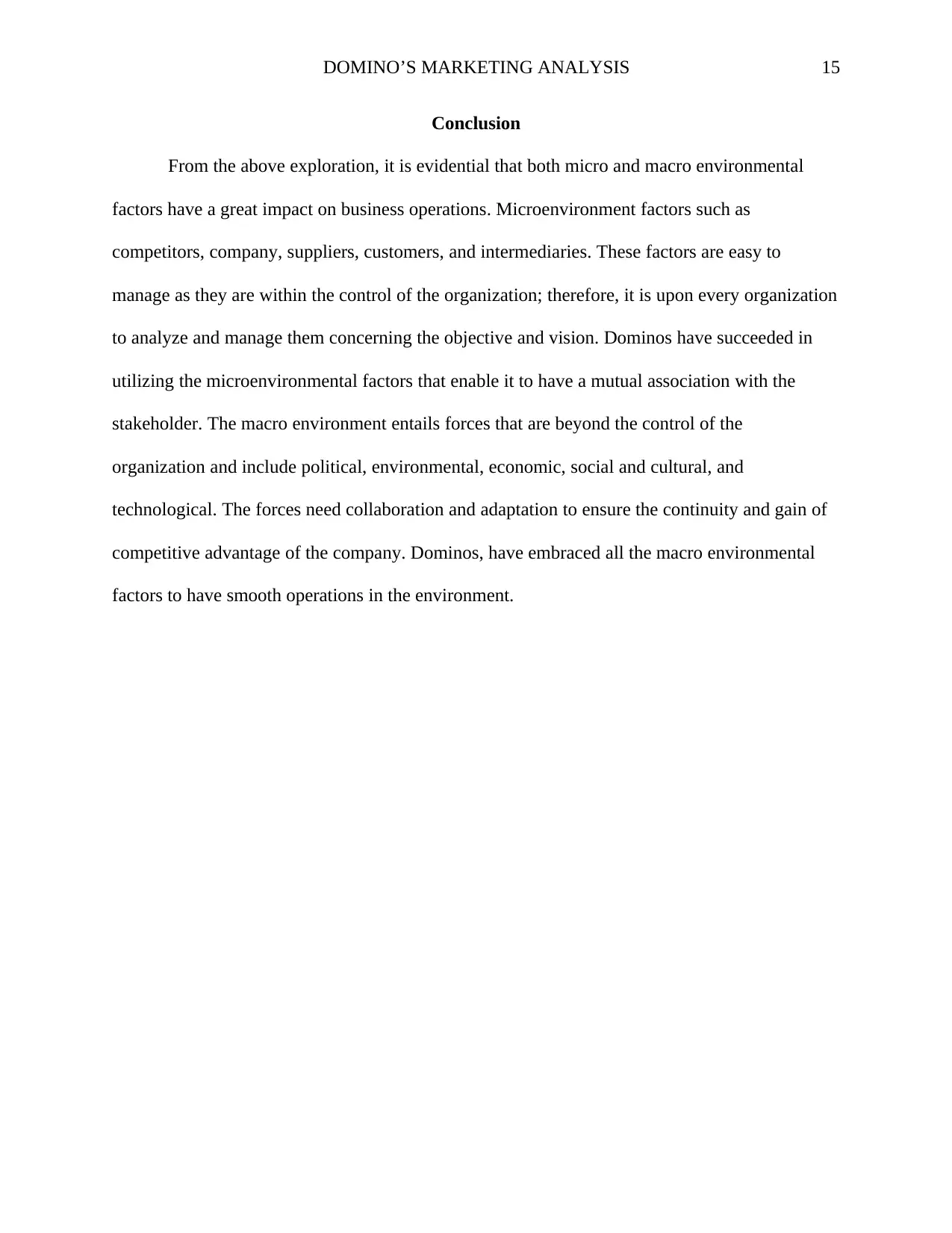
DOMINO’S MARKETING ANALYSIS 15
Conclusion
From the above exploration, it is evidential that both micro and macro environmental
factors have a great impact on business operations. Microenvironment factors such as
competitors, company, suppliers, customers, and intermediaries. These factors are easy to
manage as they are within the control of the organization; therefore, it is upon every organization
to analyze and manage them concerning the objective and vision. Dominos have succeeded in
utilizing the microenvironmental factors that enable it to have a mutual association with the
stakeholder. The macro environment entails forces that are beyond the control of the
organization and include political, environmental, economic, social and cultural, and
technological. The forces need collaboration and adaptation to ensure the continuity and gain of
competitive advantage of the company. Dominos, have embraced all the macro environmental
factors to have smooth operations in the environment.
Conclusion
From the above exploration, it is evidential that both micro and macro environmental
factors have a great impact on business operations. Microenvironment factors such as
competitors, company, suppliers, customers, and intermediaries. These factors are easy to
manage as they are within the control of the organization; therefore, it is upon every organization
to analyze and manage them concerning the objective and vision. Dominos have succeeded in
utilizing the microenvironmental factors that enable it to have a mutual association with the
stakeholder. The macro environment entails forces that are beyond the control of the
organization and include political, environmental, economic, social and cultural, and
technological. The forces need collaboration and adaptation to ensure the continuity and gain of
competitive advantage of the company. Dominos, have embraced all the macro environmental
factors to have smooth operations in the environment.
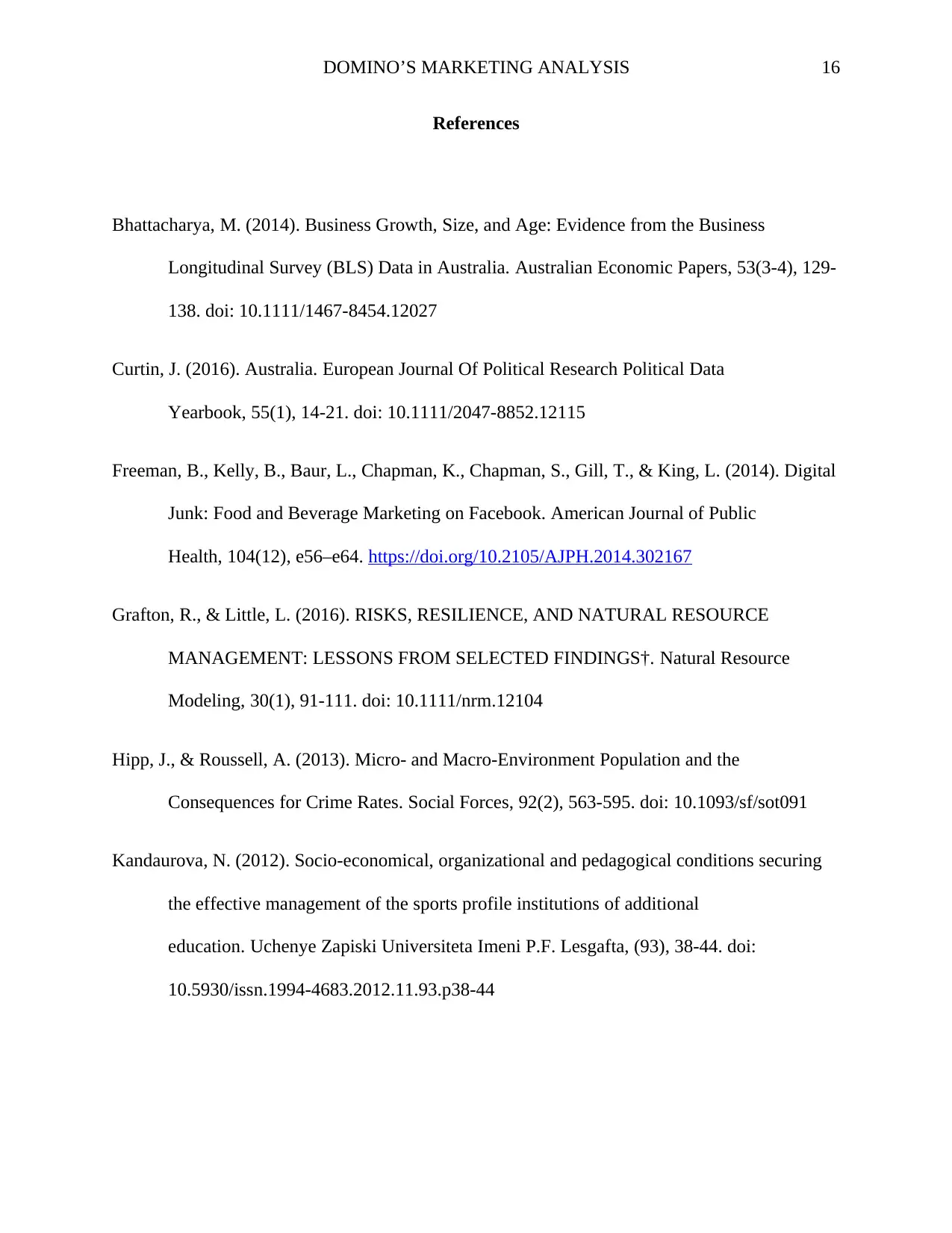
DOMINO’S MARKETING ANALYSIS 16
References
Bhattacharya, M. (2014). Business Growth, Size, and Age: Evidence from the Business
Longitudinal Survey (BLS) Data in Australia. Australian Economic Papers, 53(3-4), 129-
138. doi: 10.1111/1467-8454.12027
Curtin, J. (2016). Australia. European Journal Of Political Research Political Data
Yearbook, 55(1), 14-21. doi: 10.1111/2047-8852.12115
Freeman, B., Kelly, B., Baur, L., Chapman, K., Chapman, S., Gill, T., & King, L. (2014). Digital
Junk: Food and Beverage Marketing on Facebook. American Journal of Public
Health, 104(12), e56–e64. https://doi.org/10.2105/AJPH.2014.302167
Grafton, R., & Little, L. (2016). RISKS, RESILIENCE, AND NATURAL RESOURCE
MANAGEMENT: LESSONS FROM SELECTED FINDINGS†. Natural Resource
Modeling, 30(1), 91-111. doi: 10.1111/nrm.12104
Hipp, J., & Roussell, A. (2013). Micro- and Macro-Environment Population and the
Consequences for Crime Rates. Social Forces, 92(2), 563-595. doi: 10.1093/sf/sot091
Kandaurova, N. (2012). Socio-economical, organizational and pedagogical conditions securing
the effective management of the sports profile institutions of additional
education. Uchenye Zapiski Universiteta Imeni P.F. Lesgafta, (93), 38-44. doi:
10.5930/issn.1994-4683.2012.11.93.p38-44
References
Bhattacharya, M. (2014). Business Growth, Size, and Age: Evidence from the Business
Longitudinal Survey (BLS) Data in Australia. Australian Economic Papers, 53(3-4), 129-
138. doi: 10.1111/1467-8454.12027
Curtin, J. (2016). Australia. European Journal Of Political Research Political Data
Yearbook, 55(1), 14-21. doi: 10.1111/2047-8852.12115
Freeman, B., Kelly, B., Baur, L., Chapman, K., Chapman, S., Gill, T., & King, L. (2014). Digital
Junk: Food and Beverage Marketing on Facebook. American Journal of Public
Health, 104(12), e56–e64. https://doi.org/10.2105/AJPH.2014.302167
Grafton, R., & Little, L. (2016). RISKS, RESILIENCE, AND NATURAL RESOURCE
MANAGEMENT: LESSONS FROM SELECTED FINDINGS†. Natural Resource
Modeling, 30(1), 91-111. doi: 10.1111/nrm.12104
Hipp, J., & Roussell, A. (2013). Micro- and Macro-Environment Population and the
Consequences for Crime Rates. Social Forces, 92(2), 563-595. doi: 10.1093/sf/sot091
Kandaurova, N. (2012). Socio-economical, organizational and pedagogical conditions securing
the effective management of the sports profile institutions of additional
education. Uchenye Zapiski Universiteta Imeni P.F. Lesgafta, (93), 38-44. doi:
10.5930/issn.1994-4683.2012.11.93.p38-44
Secure Best Marks with AI Grader
Need help grading? Try our AI Grader for instant feedback on your assignments.
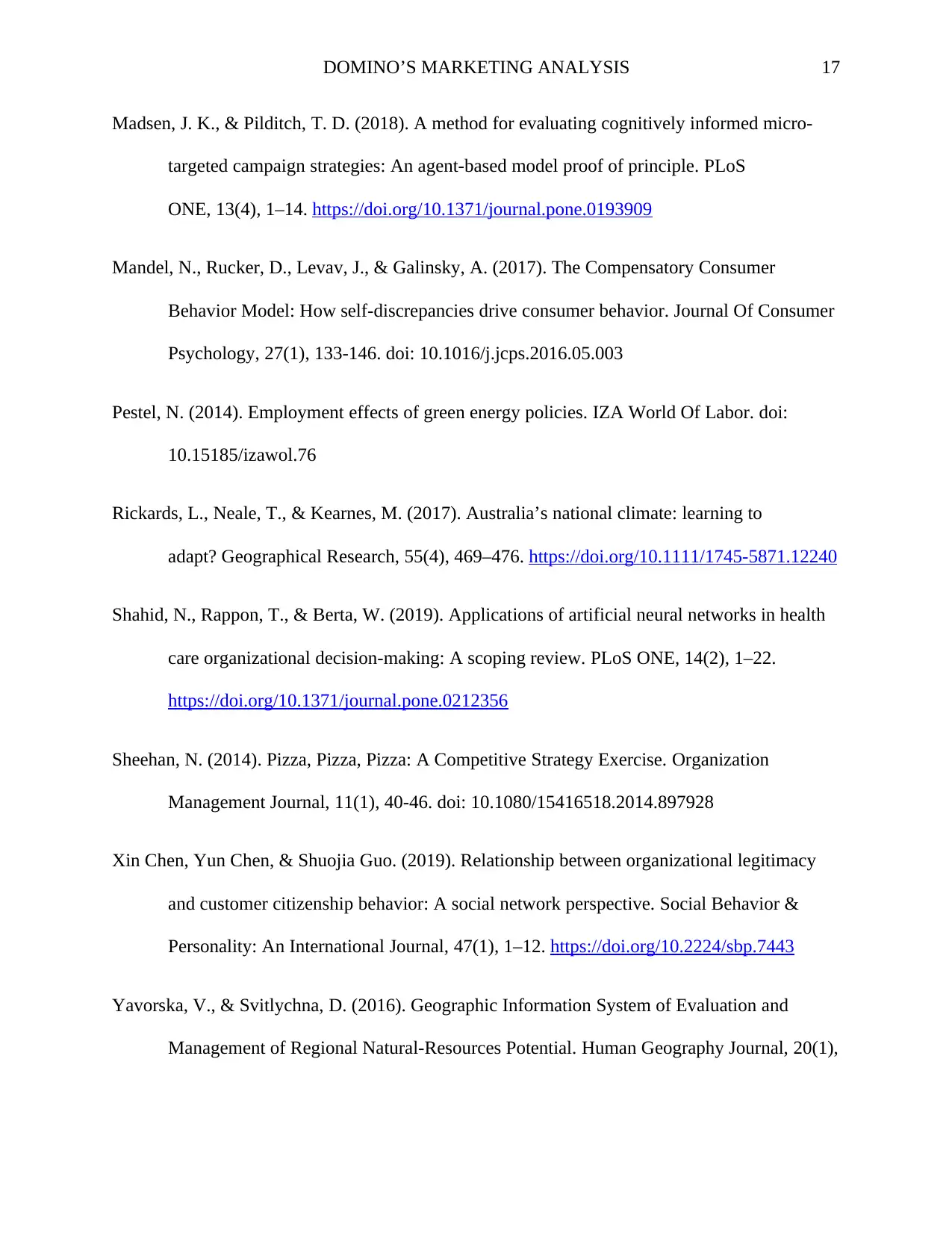
DOMINO’S MARKETING ANALYSIS 17
Madsen, J. K., & Pilditch, T. D. (2018). A method for evaluating cognitively informed micro-
targeted campaign strategies: An agent-based model proof of principle. PLoS
ONE, 13(4), 1–14. https://doi.org/10.1371/journal.pone.0193909
Mandel, N., Rucker, D., Levav, J., & Galinsky, A. (2017). The Compensatory Consumer
Behavior Model: How self-discrepancies drive consumer behavior. Journal Of Consumer
Psychology, 27(1), 133-146. doi: 10.1016/j.jcps.2016.05.003
Pestel, N. (2014). Employment effects of green energy policies. IZA World Of Labor. doi:
10.15185/izawol.76
Rickards, L., Neale, T., & Kearnes, M. (2017). Australia’s national climate: learning to
adapt? Geographical Research, 55(4), 469–476. https://doi.org/10.1111/1745-5871.12240
Shahid, N., Rappon, T., & Berta, W. (2019). Applications of artificial neural networks in health
care organizational decision-making: A scoping review. PLoS ONE, 14(2), 1–22.
https://doi.org/10.1371/journal.pone.0212356
Sheehan, N. (2014). Pizza, Pizza, Pizza: A Competitive Strategy Exercise. Organization
Management Journal, 11(1), 40-46. doi: 10.1080/15416518.2014.897928
Xin Chen, Yun Chen, & Shuojia Guo. (2019). Relationship between organizational legitimacy
and customer citizenship behavior: A social network perspective. Social Behavior &
Personality: An International Journal, 47(1), 1–12. https://doi.org/10.2224/sbp.7443
Yavorska, V., & Svitlychna, D. (2016). Geographic Information System of Evaluation and
Management of Regional Natural-Resources Potential. Human Geography Journal, 20(1),
Madsen, J. K., & Pilditch, T. D. (2018). A method for evaluating cognitively informed micro-
targeted campaign strategies: An agent-based model proof of principle. PLoS
ONE, 13(4), 1–14. https://doi.org/10.1371/journal.pone.0193909
Mandel, N., Rucker, D., Levav, J., & Galinsky, A. (2017). The Compensatory Consumer
Behavior Model: How self-discrepancies drive consumer behavior. Journal Of Consumer
Psychology, 27(1), 133-146. doi: 10.1016/j.jcps.2016.05.003
Pestel, N. (2014). Employment effects of green energy policies. IZA World Of Labor. doi:
10.15185/izawol.76
Rickards, L., Neale, T., & Kearnes, M. (2017). Australia’s national climate: learning to
adapt? Geographical Research, 55(4), 469–476. https://doi.org/10.1111/1745-5871.12240
Shahid, N., Rappon, T., & Berta, W. (2019). Applications of artificial neural networks in health
care organizational decision-making: A scoping review. PLoS ONE, 14(2), 1–22.
https://doi.org/10.1371/journal.pone.0212356
Sheehan, N. (2014). Pizza, Pizza, Pizza: A Competitive Strategy Exercise. Organization
Management Journal, 11(1), 40-46. doi: 10.1080/15416518.2014.897928
Xin Chen, Yun Chen, & Shuojia Guo. (2019). Relationship between organizational legitimacy
and customer citizenship behavior: A social network perspective. Social Behavior &
Personality: An International Journal, 47(1), 1–12. https://doi.org/10.2224/sbp.7443
Yavorska, V., & Svitlychna, D. (2016). Geographic Information System of Evaluation and
Management of Regional Natural-Resources Potential. Human Geography Journal, 20(1),
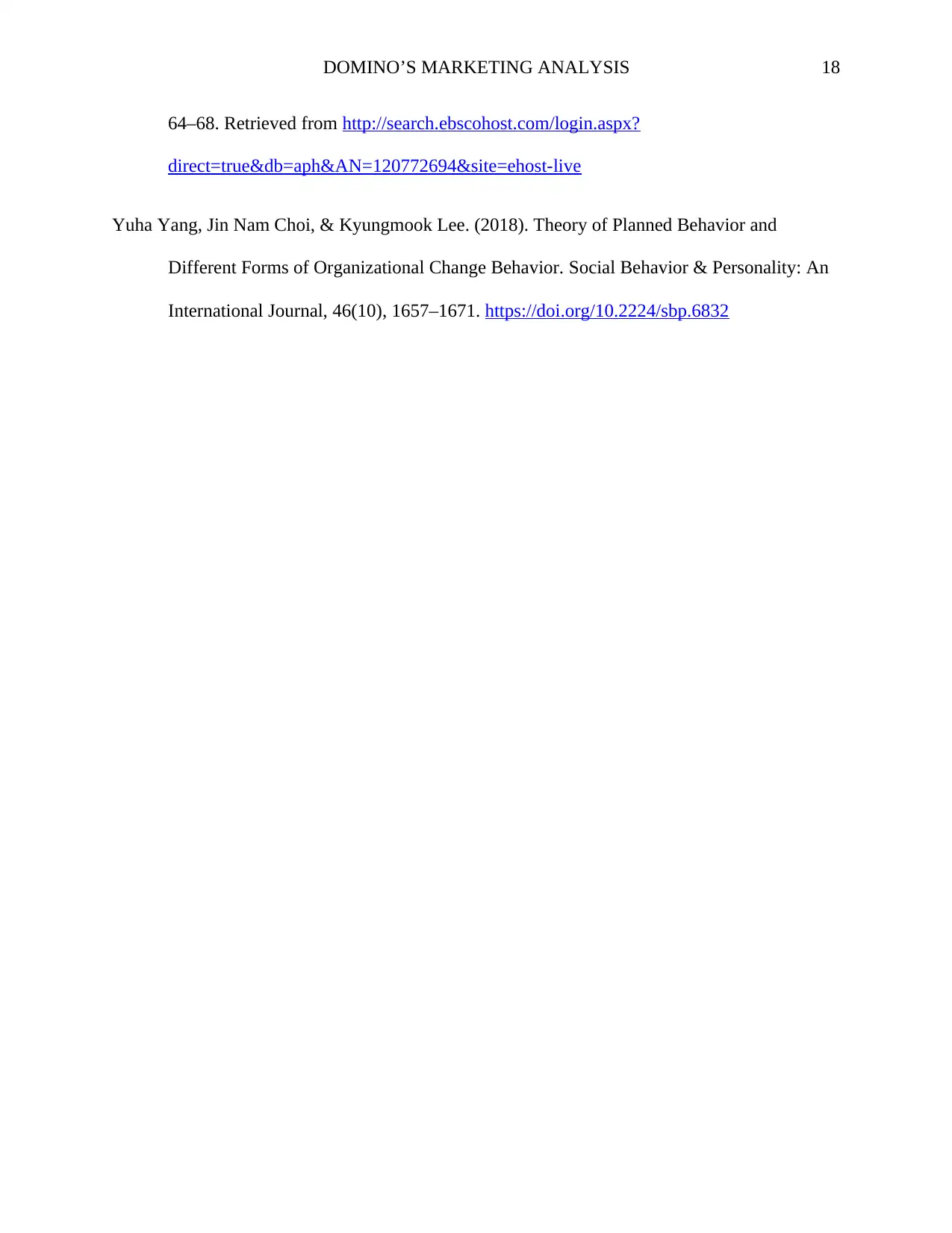
DOMINO’S MARKETING ANALYSIS 18
64–68. Retrieved from http://search.ebscohost.com/login.aspx?
direct=true&db=aph&AN=120772694&site=ehost-live
Yuha Yang, Jin Nam Choi, & Kyungmook Lee. (2018). Theory of Planned Behavior and
Different Forms of Organizational Change Behavior. Social Behavior & Personality: An
International Journal, 46(10), 1657–1671. https://doi.org/10.2224/sbp.6832
64–68. Retrieved from http://search.ebscohost.com/login.aspx?
direct=true&db=aph&AN=120772694&site=ehost-live
Yuha Yang, Jin Nam Choi, & Kyungmook Lee. (2018). Theory of Planned Behavior and
Different Forms of Organizational Change Behavior. Social Behavior & Personality: An
International Journal, 46(10), 1657–1671. https://doi.org/10.2224/sbp.6832
1 out of 18
Related Documents
Your All-in-One AI-Powered Toolkit for Academic Success.
+13062052269
info@desklib.com
Available 24*7 on WhatsApp / Email
![[object Object]](/_next/static/media/star-bottom.7253800d.svg)
Unlock your academic potential
© 2024 | Zucol Services PVT LTD | All rights reserved.





